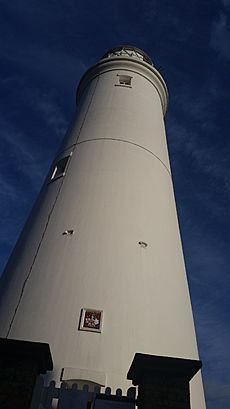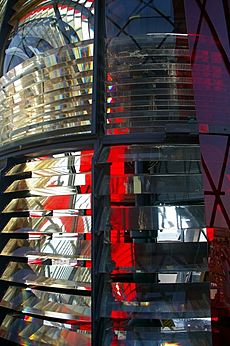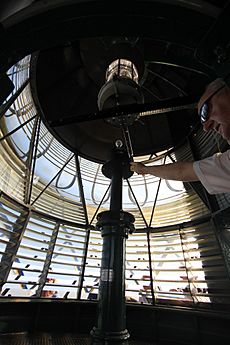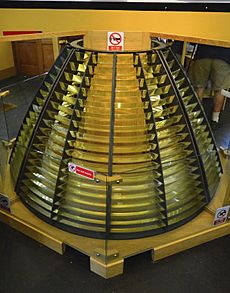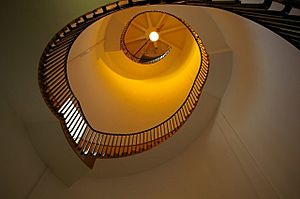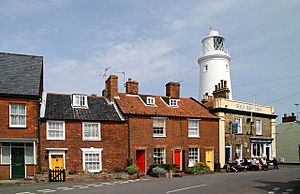Southwold Lighthouse facts for kids
| Location | Southwold, Suffolk |
|---|---|
| Coordinates | 52°19′38″N 01°40′53″E / 52.32722°N 1.68139°E |
| Year first constructed | 1890 |
| Automated | 1938 |
| Construction | brick tower |
| Tower shape | cylindrical tower with balcony and lantern |
| Markings / pattern | white tower and lantern |
| Height | 31 metres (102 ft) |
| Focal height | 37 metres (121 ft) |
| Original lens | 1st order 920 mm focal length, catadioptric fixed lens (original), Pelangi PRL400TH (current) |
| Intensity | 17,100 candela |
| Range | 24 nautical miles (44 km) |
| Characteristic | White rotating – flashing once every 10 seconds |
The Southwold Lighthouse is a tall, white lighthouse located in the town of Southwold in Suffolk, England. It stands proudly on the North Sea coast. This important lighthouse helps ships by warning them about the coastline. It also guides vessels safely into Southwold harbour.
The lighthouse is a well-known local landmark. It started working in 1890. Later, in 1938, it became automated and used electricity. Just six days after it first opened, a fire damaged its original oil lamp! Today, it uses a 180-watt main light. This light can be seen from about 24 nautical miles (44 km; 28 mi) away.
Contents
Building the Lighthouse
The building of Southwold Lighthouse began in 1887. It was led by Sir James Douglass, who was the chief engineer for Trinity House. Trinity House is the official group that manages lighthouses in England.
A temporary light was first lit in February 1889. The main lighthouse then started working on September 3, 1890. Before this, three fixed lights were used on the cliff at Southwold. These old lights were stopped once the new lighthouse was ready.
The top part of the lighthouse, called the lantern, and its special lens were not new. They were originally built in 1868 for another lighthouse called Happisburgh Low Lighthouse. When that lighthouse was taken down in 1883, its parts were saved and reused for Southwold.
How the Light Changed
When it first started, the lighthouse used an oil lamp. It showed a special light pattern: the light would go dark twice every 20 seconds. This light could be seen from about 17 nautical miles (31 km; 20 mi) away. The main light was white. However, it shone red in certain directions. These red parts warned ships about dangerous sandbanks nearby.
Just six days after the lighthouse opened, there was a fire. The oil lamp was destroyed. People thought the new lighthouse keepers were not experienced enough, which caused the fire.
The oil lamp was replaced in 1906, and then again in 1923 with a different type of oil burner. In 1938, the lighthouse became electric and automated. This meant it could run by itself without keepers always being there. The light pattern also changed to six flashes every 20 seconds. In 1965, this was changed again to four flashes.
In 2001, the lighthouse was updated to run on batteries. These batteries were charged using electricity from the main power supply.
Modern Updates
For many years, the main light came from three 90-watt lamps. These lamps could be seen from about 17 nautical miles (31 km; 20 mi) away. In 2005, Trinity House considered closing Southwold Lighthouse. This was because more ships were using satellite navigation systems instead of relying on lighthouses. However, after a review in 2009, both Southwold and Lowestoft lighthouses were saved. It was decided that satellite systems were not yet fully reliable.
In December 2012, the range of Southwold's light was made longer. It could now be seen from 24 nautical miles (44 km; 28 mi) away. This change was made because another lighthouse, Orfordness Lighthouse, was going to close in June 2013. To make the light stronger, a new, more powerful lamp was installed. This new lamp was placed inside a small spinning lens.
To make space for the new equipment, the top part of the old lens was removed. One piece of it is now on display at the bottom of the lighthouse. Another piece was sent to Happisburgh Lighthouse, where it is also on display. The middle and bottom parts of the old lens, along with its lamp, are kept as a backup in case of an emergency.
Current Light Display
Since January 2016, the lighthouse has used a 180-watt LED lamp. This lamp spins and shows one white flash every 10 seconds. This white light helps ships with general navigation. Before 2012, the lighthouse also used red lights to mark dangerous areas. However, these red lights were removed during the 2012 updates.
Lighthouse Structure
The Southwold Lighthouse is 31 metres (102 ft) tall. It stands 37 metres (121 ft) above sea level. It is built from brick and painted white. Inside, there are 113 steps that wind around a spiral staircase.
Instead of living inside the lighthouse, the keepers lived in two cottages built next to it. The lighthouse is a "Grade II listed building," which means it is an important historical structure.
Today, you can take guided tours of the lighthouse. These tours are run by the Adnams brewery, which is located nearby. You can book a visit through their website.
The lighthouse has also been used for charity events. In 2009, 2011, and 2013, people did "abseiling" (climbing down ropes) from the lighthouse. These events raised money for the Southwold lifeboat, which is operated by the RNLI to help people at sea.
See also
- List of lighthouses in England


